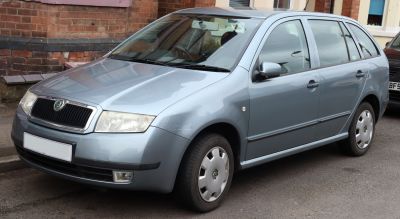 1973 Opel Kadett C Caravan Dimensions, Size & Specs
1973 Opel Kadett C Caravan Dimensions, Size & SpecsMeasurements of the 1973 Opel Kadett C Caravan, engineered for optimal performance and comfort
| Dimensions | |
|---|---|
| Length: | 4140-4198 mm163.0-165.3 in13.6-13.8 ft |
| Width: | 1580 mm62.2 in5.2 ft |
| Height: | 1385 mm54.5 in4.5 ft |
| Trunk Capacity: | 450 liter15.9 cu ft |
| Trunk Capacity (Max): | 450 liter15.9 cu ft |
| Weight Specifications | |
| Curb Weight: | 800-820 kg1764-1808 lbs |
| Maximal permitted Weight: | 1250-1270 kg2756-2800 lbs |
| Roof Load: | 60 kg132 lbs |
| Tire Specifications | |
| Rims Size: |
|
| Tire Sizes: |
|
The Opel Kadett C Caravan, produced from 1973 to 1979, is a classic German station wagon that blends compact dimensions with practical versatility. Measuring between 4140 mm and 4198 mm in length (approximately 163 to 165.3 inches), 1580 mm (62.2 inches) in width, and 1385 mm (54.5 inches) in height, this vehicle offers a balanced size suited to urban driving and family use. With a curb weight ranging from 800 to 820 kg (1764 to 1808 lbs) and a maximum allowable weight between 1250 and 1270 kg (2756 to 2799 lbs), the Kadett C Caravan provides a lightweight yet sturdy platform. It rides on 13-inch rims with tire sizes 155/80 SR13 or 155 SR13, typical for its era and class. The station wagon boasts a generous luggage capacity of 450 liters (15.9 cubic feet), which remains the same even with the rear seats folded, highlighting its consistent cargo space. Additionally, the roof can safely support a load of up to 60 kg (132 lbs), making it useful for extra storage options such as roof racks or luggage boxes. Overall, the Opel Kadett C Caravan exemplifies the efficient and practical family-oriented design of the 1970s, making it an interesting subject for car size comparison and enthusiasts of vintage station wagons.
Discover the standout features that make the 1973 Opel Kadett C Caravan a leader in its class
Have a question? Please check our knowledgebase first.
The Opel Kadett C Caravan, produced from 1973 to 1979, has a length ranging between 4140 mm to 4198 mm (approximately 163 to 165.3 inches). This moderate length for a station wagon makes it practical for urban and suburban driving, allowing it to fit comfortably in most parking spaces while providing ample interior space for passengers and cargo. Its length is well-suited for daily use without being cumbersome, enhancing both maneuverability and cargo capacity.
The width of the Opel Kadett C Caravan is 1580 mm (approximately 62.2 inches). This makes the car relatively narrow compared to modern station wagons, which benefits maneuverability and ease of parking in tight spots, especially in congested city environments or narrow parking garages. The narrower width also contributes to a lighter curb weight, aiding driving dynamics and fuel efficiency.
The Opel Kadett C Caravan stands at 1385 mm (about 54.5 inches) in height. This relatively low profile for a station wagon improves aerodynamics, which can positively impact fuel efficiency and driving stability at higher speeds. Despite its modest height, the interior space, particularly headroom, is adequate for most passengers and cargo, making it a practical choice for families or those needing versatility.
The curb weight of the Opel Kadett C Caravan ranges from 800 to 820 kilograms (approximately 1764 to 1808 pounds), while the maximum permissible weight is between 1250 to 1270 kilograms (about 2756 to 2800 pounds). This light curb weight contributes to nimble handling and better fuel efficiency. The weight capacity suggests it can carry a substantial payload including passengers and cargo, making it a practical vehicle for varied everyday uses.
The Opel Kadett C Caravan offers a luggage capacity of 450 liters (about 15.9 cubic feet) regardless of whether the rear seats are up or folded down. This consistent volume indicates the design places emphasis on a spacious cargo area, ideal for transporting groceries, luggage, or other equipment. The flexibility of the rear compartment makes it suitable for family trips or small-scale commercial usage.
The roof load capacity of the Opel Kadett C Caravan is 60 kilograms (approximately 132 pounds). This means it can safely carry additional items such as roof boxes, bicycles, or luggage racks without compromising the vehicle's stability or safety. This feature enhances the car's practicality, especially for vacationers or those needing to transport bulky items that do not fit inside the cabin.
Yes, the Opel Kadett C Caravan fits comfortably into a standard garage. With its length ranging from 4140 to 4198 mm (163 to 165.3 inches), width of 1580 mm (62.2 inches), and height of 1385 mm (54.5 inches), it falls well within typical garage dimensions in most regions. Its compact size and manageable proportions make it easy to park indoors, protecting the vehicle from weather elements and enhancing security.
Compared to its predecessor, the Opel Kadett C Caravan generally offers increased body length and improved cargo capacity. The predecessor models were slightly more compact and less spacious. The C Caravan's enhanced dimensions translate into greater interior room and luggage space, making it more versatile as a family or utility vehicle. These improvements, combined with modernization in styling and chassis design, positioned the Kadett C Caravan as a more competitive and practical station wagon in its segment.
The Opel Kadett C Caravan stands competitive among 1970s station wagons with its balanced size—length around 4.14 to 4.2 meters and a moderate width of 1.58 meters. While some contemporaries may be larger or offer more cargo volume, the Kadett Caravan's lightweight construction (around 800 kg) contributes to better fuel economy and agility. Its 450-liter luggage space is practical for typical family duties, though larger rivals may provide more room. Overall, it strikes a good balance between compactness for city use and cargo capacity for longer trips.
The Opel Kadett C Caravan is equipped with 13-inch rims paired with 155/80 SR13 or 155 SR13 tires. The relatively narrow tire width and smaller rim size reflect the vehicle's lightweight build and focus on comfort rather than sporty handling. This setup provides good fuel efficiency, a smooth ride, and adequate grip for everyday driving conditions. The smaller rims also contribute to lower replacement costs and ease of maintenance, aligning with the car's practical, economical nature.
Discover similar sized cars.

| Production: | 1999-2004 |
|---|---|
| Model Year: | 2000 |
| Length: | 4222 mm166.2 in |
| Width: | 1646 mm64.8 in |
| Height: | 1452 mm57.2 in |
